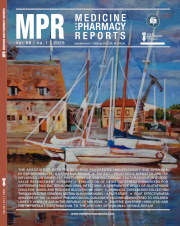Umbilical cord blood collection through elective cesarean section in an ovine model – a pilot study
DOI:
https://doi.org/10.15386/mpr-2843Keywords:
cesarean section, umbilical cord blood collection, ovine model, stem cellAbstract
Background. Despite advancements in congenital heart surgery, long-term outcomes remain challenging, with many patients developing heart failure and requiring transplants at a young age. Stem cell therapy, particularly using umbilical cord-derived mesenchymal stem cells, is emerging as a promising adjunct treatment. Adult studies suggest functional improvements, but pediatric research remains sparse. This pilot study aimed to establish surgical and anesthetic protocols for elective cesarean section in an ovine model to enable umbilical cord blood collection.
Methods. Three pregnant sheep aged 2–6 years and weighing 40–45 kg underwent elective cesarean section. Gestational age was confirmed using ultrasound and clinical signs. Preoperative preparation involved fasting, dexamethasone administration to prevent respiratory distress, and shaving surgical sites. Local anesthesia and mild sedation (medetomidine) minimized fetal exposure to anesthetics. Two umbilical cord blood collection methods were tested: active aspiration and gravitational collection.
Results. We established efficient anesthetic and surgical protocols for elective cesarean section and described a safe and easy method for umbilical cord blood collection with minimal risk. Elective cesarean section ensures a sterile environment, crucial for stem cell isolation. Local anesthesia with mild sedation proved safe and provided proper comfort for animals and operators. Accurate gestational estimation and effective postnatal care were critical.
Conclusions. This study provides a reliable protocol for elective cesarean section and umbilical cord blood collection in an ovine model, offering a valuable foundation for research in stem cell therapy. However, larger sample sizes are needed to validate these methods and enhance their applicability in translational research.
Downloads
Published
How to Cite
Issue
Section
License
The authors are required to transfer the copyright of the published paper to the journal. This is done by agreeing to sign the Copyright Assignment Form. Whenever the case, authors are also required to send permissions to reproduce material (such as illustrations) from the copyright holder.

The papers published in the journal are licensed under a Creative Commons Attribution-NonCommercial-NoDerivatives 4.0 International License.

